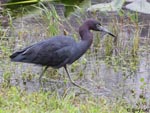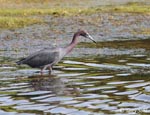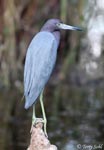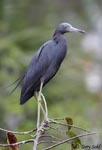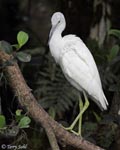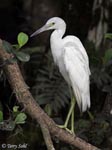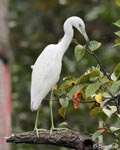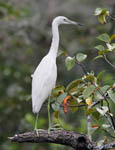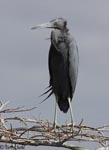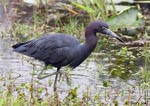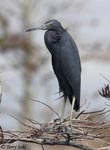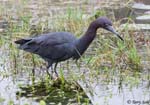| Length: 26 inches | Wingspan: 40 inches | Seasonality: Summer |
| ID Keys: Dark bluish-gray overall, gray bill with black tip. Immatures have all-white plumage. | ||
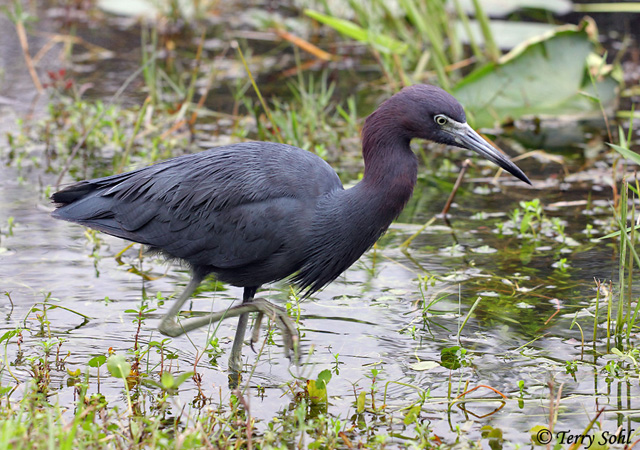 A smaller heron that is normally found in the southeastern
United States. Little Blue Herons can sometimes be quite wary and difficult
to approach as they wade in shallow marshes and sloughs, but in parts of their
range where they are habituated to a human presence, such as along popular
trails in the Everglades, they can be very approachable. Immature
birds have an all-white plumage and can be very similar in appearance to Snowy
Egrets (see photos at bottom of page for examples of juvenile plumage for
the Little Blue Heron). Mature birds are dark bluish gray overall, as
in the photo to the right. Little Blue Herons have been expanding their range to the
north in recent decades, and are becoming more commonly seen in the upper Great
Plains.
A smaller heron that is normally found in the southeastern
United States. Little Blue Herons can sometimes be quite wary and difficult
to approach as they wade in shallow marshes and sloughs, but in parts of their
range where they are habituated to a human presence, such as along popular
trails in the Everglades, they can be very approachable. Immature
birds have an all-white plumage and can be very similar in appearance to Snowy
Egrets (see photos at bottom of page for examples of juvenile plumage for
the Little Blue Heron). Mature birds are dark bluish gray overall, as
in the photo to the right. Little Blue Herons have been expanding their range to the
north in recent decades, and are becoming more commonly seen in the upper Great
Plains.
Habitat: Marshes and sloughs, margins of shallow ponds and lakes with emergent vegetation.
Diet: Mostly fish and crustaceans, also frogs, tadpoles, insects, snakes, lizards, and small rodents.
Behavior: Stands still or walks slowly through the shallows, searching for prey, and grabbing it with a thrust of the neck and head when prey is spotted. They will also feed on shore, and occasionally in grassy meadows or other upland habitat.
Nesting: Rare breeder in South Dakota. Little Blue Herons are colonial nesters. The nest is a platform of sticks, placed in a tree or large shrub, sometimes quite high off the ground. The female usually lays between 3 and 5 eggs, and both parents help to incubate them. When the eggs hatch, both parents help feed the young. The young begin to fledge after 4 weeks, and leave the care of the parents 2 or 3 weeks after fledging.
Song: Aah-oo-ah-ah-ah by male during courtship.
Migration: Summers in the Southeastern U.S., and in scattered locations elsewhere in the U.S. Winters along Gulf Coast, Florida, Mexico, Central America, and South America.
Interactive eBird Map: Click here to access an interactive eBird map of Little Blue Heron sightings
Similar Species: Tricolored Heron. Immatures similar to Snowy Egret, Great Egret, and Cattle Egret. See Identification Tips page for differentiating between the white Egrets and the immature Little Blue Heron.
Conservation Status: Has been increasing in number and increasing range northward in recent decades.
Further Information: 1) USGS Patuxent Bird Identification InfoCenter, Little Blue Heron
2) Audubon Guide - Little Blue Heron
3) Whatbird.com: Little Blue Heron
Photo Information: December 10th, 2012 - Everglades National Park in Florida - Terry Sohl
Additional Photos: Click on the image chips or text links below for additional, higher-resolution Little Blue Heron photos.
| Click on the map below for a higher-resolution view |
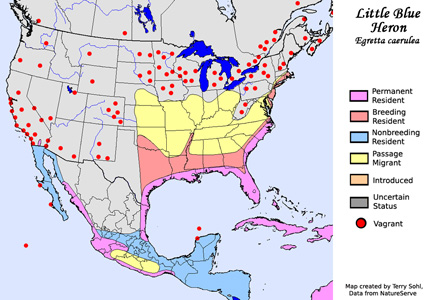 |
| South Dakota Status: Rare summer resident in the northeastern part of the state, casual migrant and summer resident elsewhere in the east. |
Additional Little Blue Heron Photos
Click for a higher-resolution version of these photos
